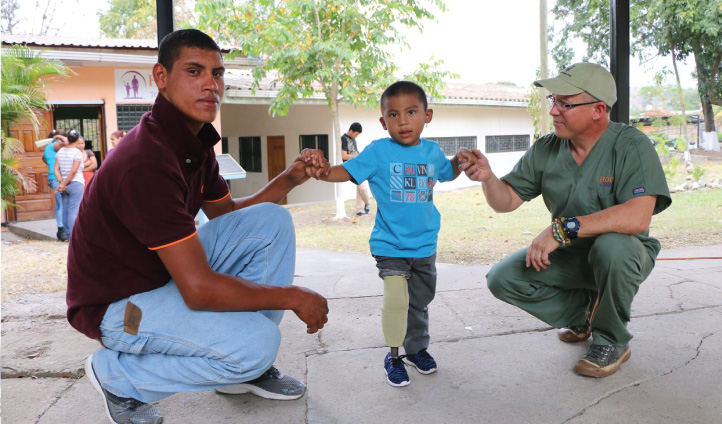For Phil Johnson, frustration was the mother of invention.
When Johnson traveled to Guatemala several years ago to provide a prosthetic leg to a young boy, he was overwhelmed the next morning when 15 children waited outside the clinic hoping for one, too.
With traditional prosthetics that start at $5,000 and can exceed $80,000, Johnson knew he’d never be able to meet that need.
A Kindred Spirit:
Hope to Walk was formed after Johnson met Michael Mabry, when he was a first-year medical student at the Edward Via College of Osteopathic Medicine. The pair shared a passion for helping others and took a trip to Honduras in 2014 to assess the needs of amputees.
Tapping his 30 years of experience in orthotics and prosthetics, Johnson developed a prosthetic leg that can be built for about $65 by attaching a PVC pipe filled with a wooden dowel to a crepe foam foot with a wooden heel. The socket for the stump is crafted using fiberglass and is attached to the leg using a plastic PVC cap.
“I wanted to create a leg that anybody could afford,” Johnson said.
An Expanding Mission:
Since the non-profit launched in 2015, Johnson, Mabry and other volunteers have traveled to Honduras, Guatemala, Haiti and Vietnam to give prosthetic legs to more than 300 amputees.
Dr. Ken Jones, a member of Hope to Walk’s board of trustees, said the legs may not be pretty, but they work. “It gets you from point A to point B, and it’s better than being in a wheelchair.”
Hope to Walk’s prosthetic legs last about three years, Jones said, which is comparable to the lifespan of a high-tech prosthetic leg made of titanium and carbon graphite.
Volunteer Mara Pineda, who is originally from Honduras, said the volunteers are able to provide about 20 legs per trip and are working to help develop clinics in other countries so eventually volunteers will be able to build legs on site. VCOM has been instrumental in helping establish Hope to Walk’s first prosthetic center in Honduras.
For now, the volunteers travel with legs (all one size) and feet (all one size and no differentiation between right and left) that can be cut and shaped to fit each patient’s needs. A pair of retired wood craftsmen in Smith Mountain Lake – a shop teacher of 30 years and an expert dulcimer designer – make all of Hope to Walk’s feet, relieving Johnson of a task he had been doing himself at night.
The legs for children are built like a crutch so they can be extended as the child grows. The socket is built a bit larger than needed, and the child is given extra cast socks to provide cushion. As the child grows, the socks can be eliminated.
The legs can be made and fitted to the patient in a day.
The World Health Organization estimates 35 million people need prosthetics. In Honduras, Guatemala and Haiti, adults most often need prosthetic legs due to diabetes. Young adults often lose limbs in motorcycle crashes and younger children are either wounded in accidents or are born with congenital deformities. In Vietnam, limbs are most often lost to landmines.
“There’s a huge need,” Jones said.
The Hope to Walk website is filled with success stories from the 4-year-old boy born without a lower leg who can now run and play to the man who walked on a bruised and possibly-broken foot for 35 years until an infection claimed his lower leg.
So far, the organization has only been able to help people with below-the-knee amputations, but Johnson is fine-tuning a prosthetic that will work with an above-the-knee amputation. Students from the Virginia Tech School of Engineering are collaborating with Johnson to help develop an innovative, low-cost artificial knee joint.
Overwhelming Support:
Good ideas spread quickly and people, institutions and organizations in the region have embraced Hope to Walk’s mission.
Physical therapy students at Radford University worked with their instructor, Wil Kolb, to create a teaching video that Hope to Walk volunteers use to help Third World amputees receiving prosthetic legs.
The Blacksburg-Christiansburg Chamber of Commerce selected Hope to Walk as the recipient of its 2018 Legacy Project so several teams of chamber members are devoting time and expertise to mentor Hope to Walk volunteers as they hone their skills in marketing, finance and management.
Several New River Valley physicians and business leaders have contributed time and money and the Christiansburg Fire Department donated its conference hall for Hope to Walk’s spring banquet, which drew more than 300 area supporters and raised more than $50,000 to provide new legs for the world’s poorest amputees.
And when the Gorilla Glue Corporation learned Hope to Walk was securing the dowels inside the PVC pipe with their product, the company contacted the organization to donate all the glue it needs.
Johnson also is filing for patents to protect his designs and ensure Hope to Walk can continue to produce the legs. The value of the work he and the Hope to Walk volunteers are doing is priceless, he told The Roanoke Times.
“To see the smiles on these people’s faces when they first stand up, there’s no money in the world worth it.”

